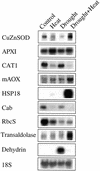The combined effect of drought stress and heat shock on gene expression in tobacco
- PMID: 12427981
- PMCID: PMC166635
- DOI: 10.1104/pp.006858
The combined effect of drought stress and heat shock on gene expression in tobacco
Abstract
In nature, plants encounter a combination of environmental conditions that may include stresses such as drought or heat shock. Although drought and heat shock have been extensively studied, little is known about how their combination affect plants. We used cDNA arrays, coupled with physiological measurements, to study the effect of drought and heat shock on tobacco (Nicotiana tabacum) plants. A combination of drought and heat shock resulted in the closure of stomata, suppression of photosynthesis, enhancement of respiration, and increased leaf temperature. Some transcripts induced during drought, e.g. those encoding dehydrin, catalase, and glycolate oxidase, and some transcripts induced during heat shock, e.g. thioredoxin peroxidase, and ascorbate peroxidase, were suppressed during a combination of drought and heat shock. In contrast, the expression of other transcripts, including alternative oxidase, glutathione peroxidase, phenylalanine ammonia lyase, pathogenesis-related proteins, a WRKY transcription factor, and an ethylene response transcriptional co-activator, was specifically induced during a combination of drought and heat shock. Photosynthetic genes were suppressed, whereas transcripts encoding some glycolysis and pentose phosphate pathway enzymes were induced, suggesting the utilization of sugars through these pathways during stress. Our results demonstrate that the response of plants to a combination of drought and heat shock, similar to the conditions in many natural environments, is different from the response of plants to each of these stresses applied individually, as typically tested in the laboratory. This response was also different from the response of plants to other stresses such as cold, salt, or pathogen attack. Therefore, improving stress tolerance of plants and crops may require a reevaluation, taking into account the effect of multiple stresses on plant metabolism and defense.
Figures





References
-
- Asada K. The water-water cycle in chloroplasts: scavenging of active oxygen and dissipation of excess photons. Annu Rev Plant Physiol Plant Mol Biol. 1999;50:601–639. - PubMed
-
- Bowler C, Fluhr R. The role of calcium and activated oxygens as signals for controlling cross-tolerance. Trends Plant Sci. 2000;5:241–246. - PubMed
Publication types
MeSH terms
LinkOut - more resources
Full Text Sources
Other Literature Sources

